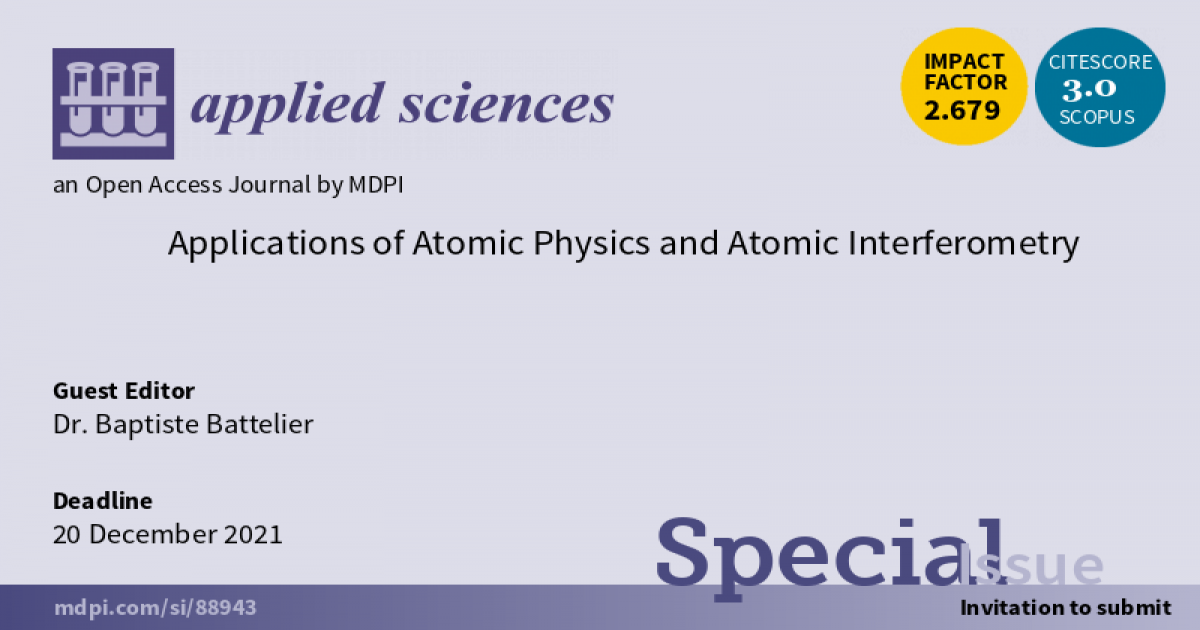Applications of Atomic Physics and Atomic Interferometry
A special issue of Applied Sciences (ISSN 2076-3417). This special issue belongs to the section "Applied Physics General".
Deadline for manuscript submissions: closed (20 August 2022) | Viewed by 6193

Special Issue Editor
Special Issue Information
Dear Colleagues,
Strong efforts are currently being made to transfer quantum technology into industry, in a context of strong international financial support (UK quantum HUB, Quantum flagship and Horizon Europe, etc.). Among these technologies, cold atoms sensors already have a significant maturity, allowing us to envision applications in the short term. Atomic clocks have demonstrated outstanding long-term stability and accuracy and serve as the primary standard for the definition of the second. These systems are now compact enough to be considered for a larger community of users. Similarly, cold atom gravimeters and gyroscopes have demonstrated sensitivity and long-term stability, paving the way to a technological breakthrough for inertial sensors. Despite the initial high complexity of the first experiments, the effort of development during the past 15 years has completely changed this paradigm. Commercial atom gravimeters are now available, with performances comparable to the state of the art. The challenge today is to expand this technology, which is about to emerge in the following topics: onboard terrestrial gravimetry, gradiometry, navigation, magnetometry, and spatial geodesy, among others.
This Special Issue aims to highlight the strong dynamism to transfer atom interferometry into the industrial world, and the important interaction between the cold atom community and the potential users.
Dr. Baptiste Battelier
Guest Editor
Manuscript Submission Information
Manuscripts should be submitted online at www.mdpi.com by registering and logging in to this website. Once you are registered, click here to go to the submission form. Manuscripts can be submitted until the deadline. All submissions that pass pre-check are peer-reviewed. Accepted papers will be published continuously in the journal (as soon as accepted) and will be listed together on the special issue website. Research articles, review articles as well as short communications are invited. For planned papers, a title and short abstract (about 250 words) can be sent to the Editorial Office for assessment.
Submitted manuscripts should not have been published previously, nor be under consideration for publication elsewhere (except conference proceedings papers). All manuscripts are thoroughly refereed through a single-blind peer-review process. A guide for authors and other relevant information for submission of manuscripts is available on the Instructions for Authors page. Applied Sciences is an international peer-reviewed open access semimonthly journal published by MDPI.
Please visit the Instructions for Authors page before submitting a manuscript. The Article Processing Charge (APC) for publication in this open access journal is 2400 CHF (Swiss Francs). Submitted papers should be well formatted and use good English. Authors may use MDPI's English editing service prior to publication or during author revisions.
Keywords
- atom interferometry
- atomic clocks
- inertial sensors
- navigation
- gravimetry
- timing
- magnetometry
- cold atoms
- atomic physics
- quantum technology
Benefits of Publishing in a Special Issue
- Ease of navigation: Grouping papers by topic helps scholars navigate broad scope journals more efficiently.
- Greater discoverability: Special Issues support the reach and impact of scientific research. Articles in Special Issues are more discoverable and cited more frequently.
- Expansion of research network: Special Issues facilitate connections among authors, fostering scientific collaborations.
- External promotion: Articles in Special Issues are often promoted through the journal's social media, increasing their visibility.
- Reprint: MDPI Books provides the opportunity to republish successful Special Issues in book format, both online and in print.
Further information on MDPI's Special Issue policies can be found here.





